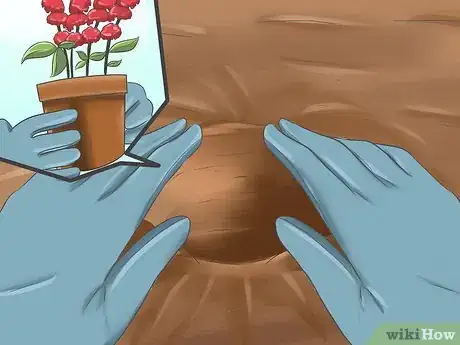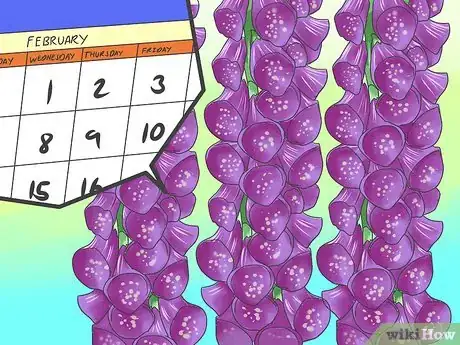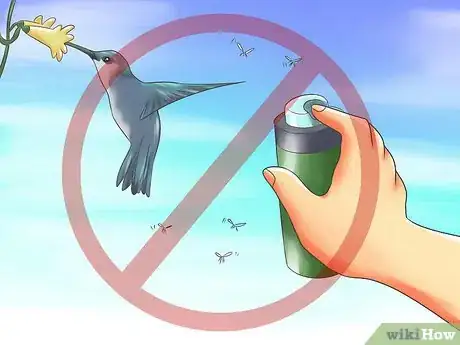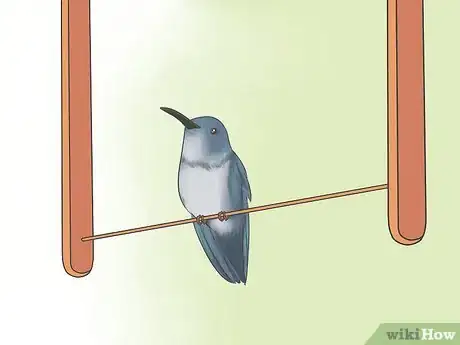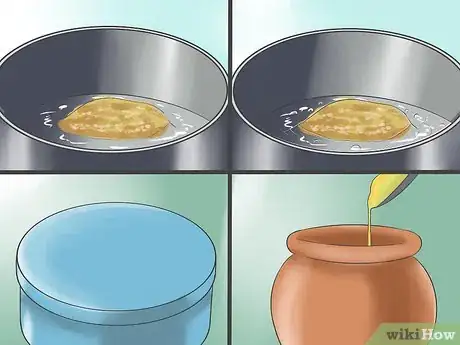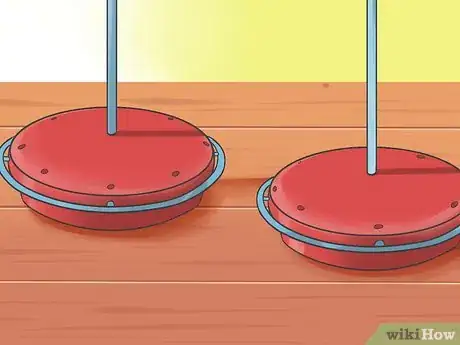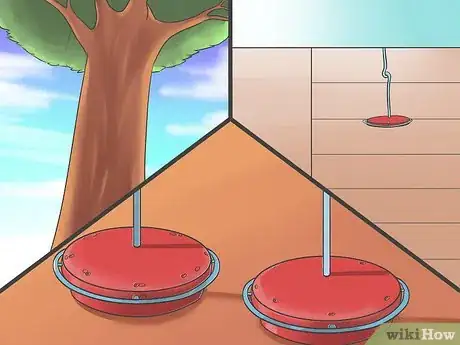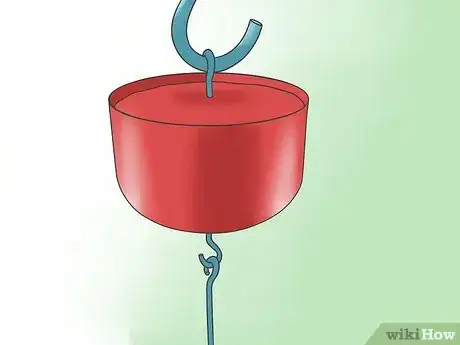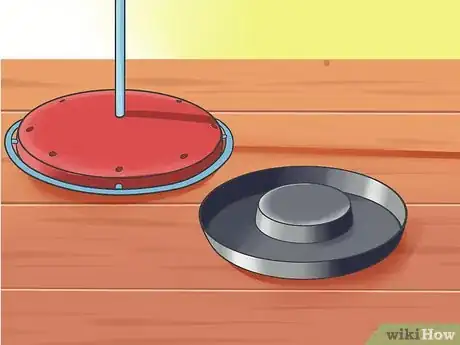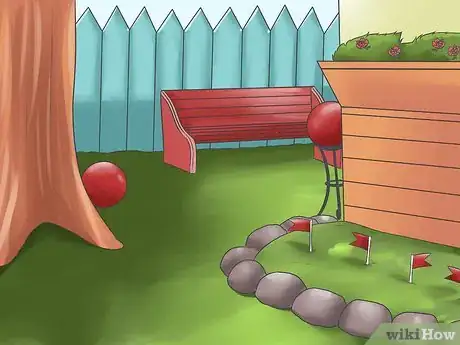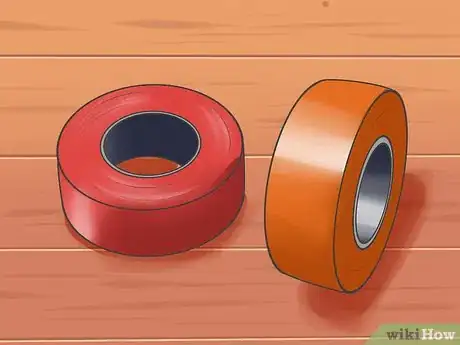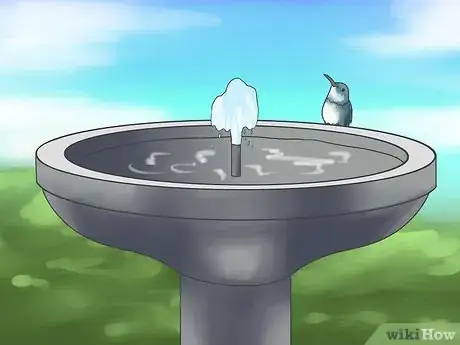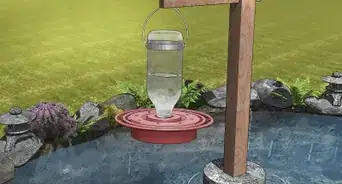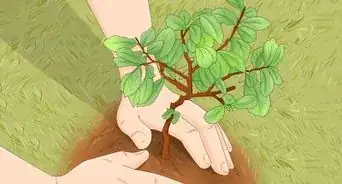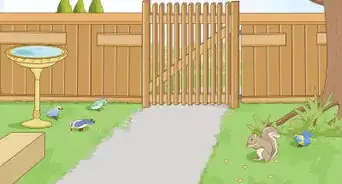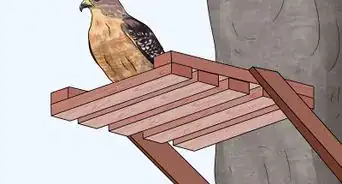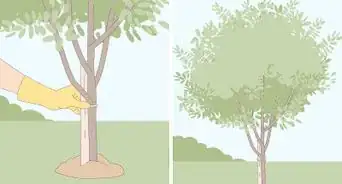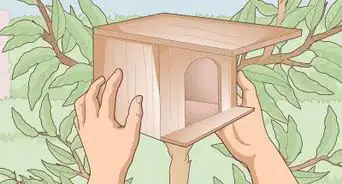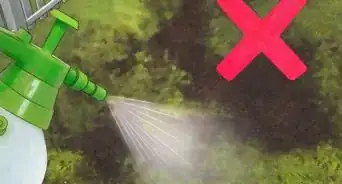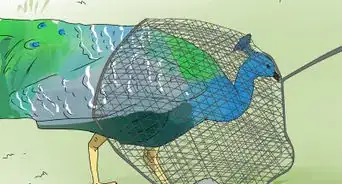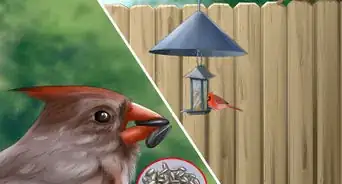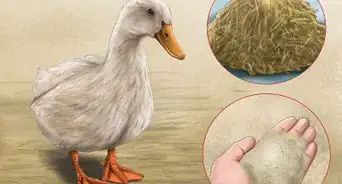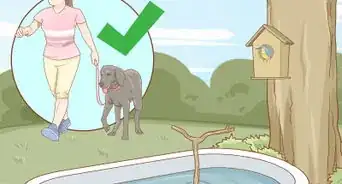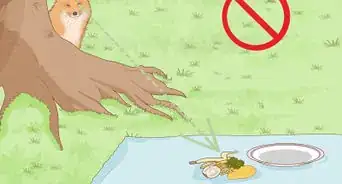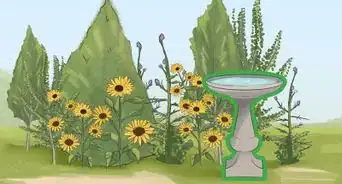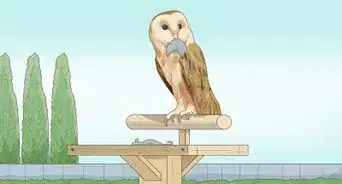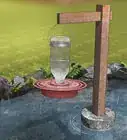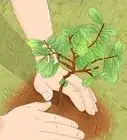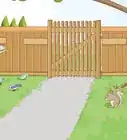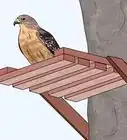This article was co-authored by Roger J. Lederer, PhD. Dr. Roger Lederer is an Ornithologist and the founder of Ornithology.com, an informative website about wild birds. Dr. Lederer has spent over 40 years teaching, studying, and writing about birds. He has traveled to over 100 countries to study birds. Dr. Lederer is an Emeritus Professor of Biological Sciences at California State University, Chico, and has been a Department Chair of Biological Sciences and Dean of the College of Natural Sciences. He has written more than 30 research papers and 10 books on birds and a textbook entitled “Ecology and Field Biology.” Dr. Lederer has consulted the BBC, National Geographic, National Public Radio, ABC News, the Guinness Book of World Records, and numerous other organizations and publications.
wikiHow marks an article as reader-approved once it receives enough positive feedback. This article received 29 testimonials and 100% of readers who voted found it helpful, earning it our reader-approved status.
This article has been viewed 184,182 times.
Hummingbirds live throughout the Western Hemisphere, and will make their home any place they can find a good source of food, water and shelter. Their small size and acrobatic flying maneuvers make them fun and entertaining to watch. Create an environment in your yard with bright colors, feeders, and a garden that will attract hummingbirds and encourage them to stay.
Steps
Attracting Hummingbirds in the Garden
-
1Plant a hummingbird garden. To get hummingbirds the natural way, plant a garden specifically geared toward what attracts them. That means a garden full of azaleas, bee balm, butterfly bushes, columbine, foxglove, hostas and morning glories (all of these are full of delicious nectar and are bright and colorful). Choose varieties that have very little smell, but have a high visibility and nectar production.
- You can use trees, vines, shrubs, and flowers, both perennials and annuals – these suggestions are just the beginning of the list. Other ideas include honeysuckle, cypress vine, coral bells, and impatiens.
- Tubular flowers hold the most nectar; therefore, these types of flowers are the most appealing to these little buzzing birds.[1]
-
2Plant on a continuous blooming schedule. Different plants and flowers bloom at different times during the spring and summer. To make sure there are always blooms in your hummingbird garden, plant some flowers that bloom early, some that bloom mid-season, and some that bloom late.
- Deadhead your flowers, too, to keep them blooming longer. This means that after blossoms have just wilted, you cut off their seed heads, tricking them into thinking they still need to bloom. They'll bloom once more healthily and heavily.
Advertisement -
3Don’t use pesticides around your hummingbird plants. The birds could ingest the pesticides, harming or even killing themselves in the process. What’s more, the birds eat the insects that the spray kills, so you would be killing their source of protein, too. In short, skip the pesticides. The hummingbirds may take care of some of the bugs for you.
- To be safe, always go all-natural, whether that means no pesticides or no artificial sugars in your nectar. Hummingbirds have delicate systems and should only ingest what is natural and safe.
-
4Provide places for hummingbirds to perch, like trees and plant hangers. Hummingbirds need breaks, too! When they're not flitting about at super high speeds, they need a place to perch. Keep branches or hangers nearby for when they need a rest.
- The male hummingbird is territorial, and guards both his space and food source. Typically, he will choose a perching spot that allows him to watch the source and keep the competition away.
Hanging Hummingbird Feeders
-
1Make your own nectar. Many believe that hummingbirds respond quickly and more consistently with homemade nectar. Make enough for each feeder to be ½ full (otherwise the nectar gets old and molds too quickly). Here’s how:
- Combine 1 part sugar with 5 parts water
- Boil 1-2 minutes
- Cool and store the liquid in a resealable container in the refrigerator
- Don't use honey or sugar sweetener in place of regular sugar. Also, there's no need to add red food coloring to the nectar—although some red color on the feeder itself can be helpful.
-
2Hang multiple red hummingbird feeders when it gets warm. To really attract hummingbirds to a feeder and to keep competition at a minimum, get multiple feeders, all of which should have red on them (their favorite color). Not enough red? Tie a ribbon on them to make spotting them even easier.
- As for “when it gets warm,” that all depends on your location. Some locations get warm in January, some in May. Whenever that is for you, make sure to hang them up at the very beginning of the season (5-10 days before you expect them) so your hummingbirds stay a while!
- Don’t take your feeders down at the end of the season! Even when your hummingbirds leave for the winter, you may get new hummingbirds that are en route somewhere that could use your feeders as a convenient pit-stop.
-
3Choose different spots to keep the birds from fighting. Your feeders should be spaced far apart and around corners where one male hummingbird can't guard them all – male hummingbirds are very territorial. This will increase hummingbird numbers by giving other males, females, and juveniles a chance to feed without being chased away by a dominate male.
- Nestle one or two in your garden, hang one up in a tree, and even consider putting one or two in your front yard, where it’s a sure thing they won’t be seen around back!
- Try to pick areas that are in the shade, at least most of the day. This will deter mold growth, which hummingbirds are not fond of.[2]
- Some people prefer to hang all their feeders together. This one no bird can be dominant, unable to fight off the wards of other birds.
-
4Buy an ant guard if necessary. Most of the feeders have them built in, but if yours doesn’t, you can buy one separately. You can also rub a little petroleum jelly on the edges to keep them away from the nectar, but this does require cleaning every couple of days.[3]
- Bees are a little harder to get rid of. A bee-proof feeder is your best shot, but even that won’t work 100% of the time. If you see nectar on the ridges of your feeder (as dripped by the birds), wipe it up to reduce temptation to the bees.
-
5Change the nectar every 3-4 days. Even if all the nectar isn’t gone, change the nectar. If you don’t, it’ll likely mold – this happens even more quickly in hotter climates. This is largely why you should only fill your feeders 1/2 full.
- With each changing of the nectar, rinse out the feeder with hot water; don’t use dish soap. If there’s mold (you'll see black spots), scrub it off or use sand and shake it until the mold comes loose.
- Hummingbirds prefer clean feeders, and actually will abandon a feeder that is neglected. To keep your hummingbirds happy, keep your feeders clean.[4]
Attracting Hummingbirds in Your Yard
-
1Decorate your yard in red. That means red gazing balls, red garden flags and red lawn furniture, in addition to more natural touches, like flowers. In their constant search for nectar-producing flowers, hungry hummingbirds are attracted to the color red more than any other. You can also turn your yard into a hummingbird magnet by hanging red bows, ribbons and decorations.
- If anything is becoming faded, dull, or the paint has rubbed off, repaint it! And if it’s just a small area that needs a touch up, red nail polish is cheap and works wonders.
-
2Use orange or red reflective surveyor’s tape. Not only is the tape useful because it’s brightly colored, it is thought that hummingbirds are sensitive to ultraviolet rays, which these fluorescent tapes reflect in abundance. You can find surveyor’s tape in most hardware stores and it's inexpensive, too.
-
3Install a shallow fountain with an upward spray or a fine mist. Because they are so small, hummingbirds usually get enough water by drinking the dew that gathers on leaves. However, they have a strong need to bathe because of the sticky nectar they eat. They love a fine mist or spray to stay cool and clean.
- Place this within sight of your feeders – as hummingbirds best sense is sight, the easier it is to see, the easier it is for them to find.
- Keep the water flowing! If the fountain is in the sun, the water may evaporate quicker than you realize. Check it every other day or so to make sure the water is running at the right level and no other animals have tainted the water.
Expert Q&A
-
QuestionWhat's the best ratio of sugar to water when you're making nectar?
 Roger J. Lederer, PhDDr. Roger Lederer is an Ornithologist and the founder of Ornithology.com, an informative website about wild birds. Dr. Lederer has spent over 40 years teaching, studying, and writing about birds. He has traveled to over 100 countries to study birds. Dr. Lederer is an Emeritus Professor of Biological Sciences at California State University, Chico, and has been a Department Chair of Biological Sciences and Dean of the College of Natural Sciences. He has written more than 30 research papers and 10 books on birds and a textbook entitled “Ecology and Field Biology.” Dr. Lederer has consulted the BBC, National Geographic, National Public Radio, ABC News, the Guinness Book of World Records, and numerous other organizations and publications.
Roger J. Lederer, PhDDr. Roger Lederer is an Ornithologist and the founder of Ornithology.com, an informative website about wild birds. Dr. Lederer has spent over 40 years teaching, studying, and writing about birds. He has traveled to over 100 countries to study birds. Dr. Lederer is an Emeritus Professor of Biological Sciences at California State University, Chico, and has been a Department Chair of Biological Sciences and Dean of the College of Natural Sciences. He has written more than 30 research papers and 10 books on birds and a textbook entitled “Ecology and Field Biology.” Dr. Lederer has consulted the BBC, National Geographic, National Public Radio, ABC News, the Guinness Book of World Records, and numerous other organizations and publications.
Ornithologist It's best to use a ratio of 5 parts water to 1 part sugar. Some people use a 4:1 ratio, but the sugar could crystallize on the hummingbird's bill, leading to a dangerous infection.
It's best to use a ratio of 5 parts water to 1 part sugar. Some people use a 4:1 ratio, but the sugar could crystallize on the hummingbird's bill, leading to a dangerous infection. -
QuestionHummingbirds were swarming my yard, but now don't come around. Why?
 Community AnswerFlowers and bright colors attract hummingbirds. Try hanging a hummingbird feeder or two filled with sugar water to attract them back.
Community AnswerFlowers and bright colors attract hummingbirds. Try hanging a hummingbird feeder or two filled with sugar water to attract them back. -
QuestionWhere do hummingbirds live?
 Community AnswerHummingbirds live all over the world. They make nests and usually migrate from the Northern part of the world to the South during winter.
Community AnswerHummingbirds live all over the world. They make nests and usually migrate from the Northern part of the world to the South during winter.
Warnings
- Never use honey or artificial sugar in your hummingbird feeder. The hummingbirds will eat it, but they cannot digest it.⧼thumbs_response⧽
- Avoid using pesticides in your hummingbird garden. In addition to nectar, hummingbirds need to eat small insects, for protein, to survive. Besides killing off the small insects that hummingbirds eat, pesticides can also enter the flower nectar and sicken the birds.⧼thumbs_response⧽
References
- ↑ http://www.almanac.com/content/plants-attract-hummingbirds
- ↑ http://wdfw.wa.gov/living/hummingbirds/
- ↑ http://wdfw.wa.gov/living/hummingbirds/
- ↑ http://www.drsfostersmith.com/pic/article.cfm?articleid=1247
- The Hummingbird Book by Donald and Lillian Stokes. Published by Little, Brown and Company. (ISBN 0-316-81715-5)
About This Article
To attract hummingbirds, start by decorating your yard with red items, like gazing balls or lawn furniture, or stick a piece of red reflective surveyor’s tape, which will attract the birds. Once birds are attracted to your yard, make your yard more appealing by setting out a feeder. To feed hummingbirds, make a nectar out of 1 part sugar and 4 parts water and boil it for 1 to 2 minutes. Then, fill your feeder with the nectar, place it in a shady spot in your yard, and replace the nectar every 3 to 4 days to keep the feeder clean. To learn how to attract hummingbirds with a garden, keep scrolling!
